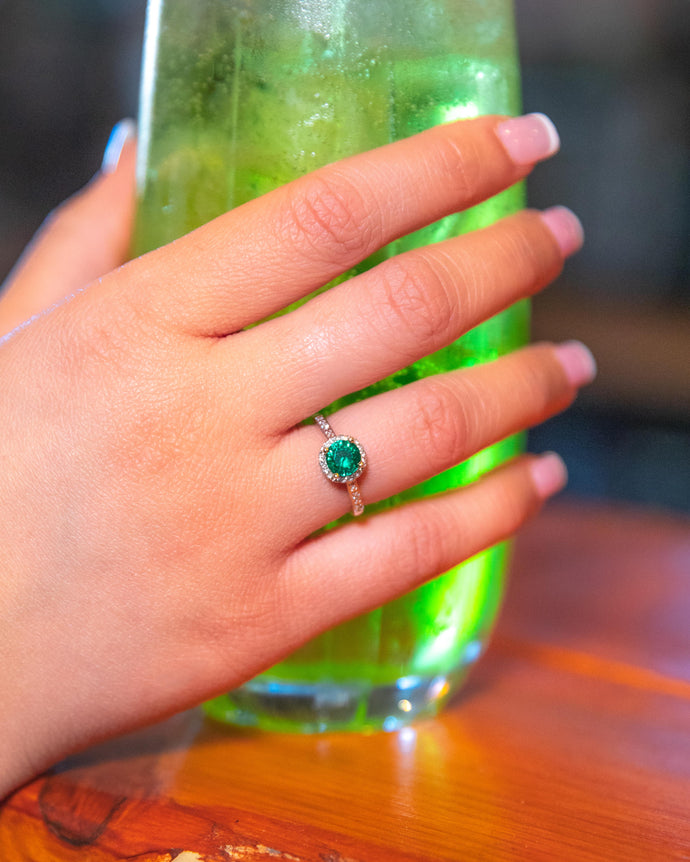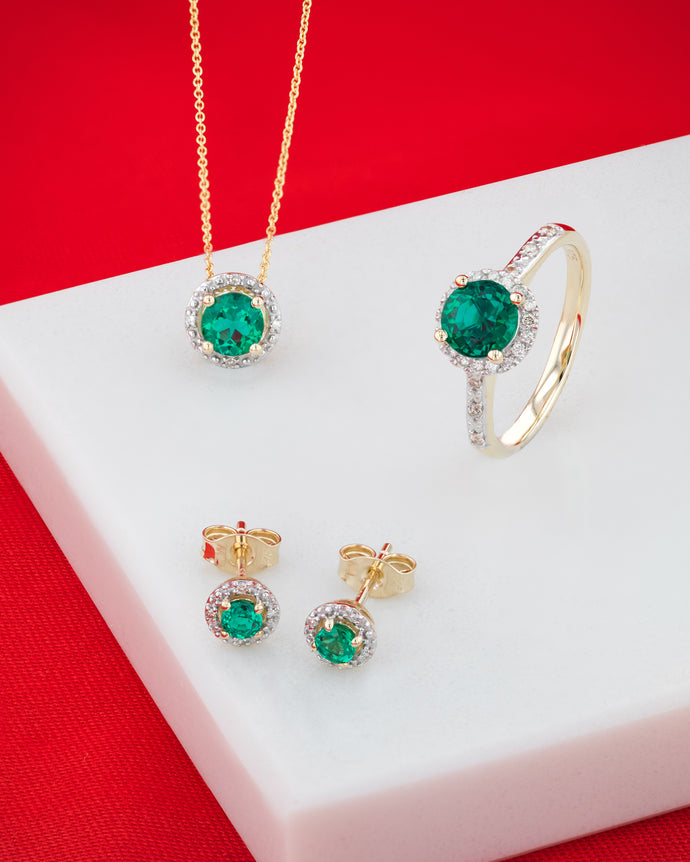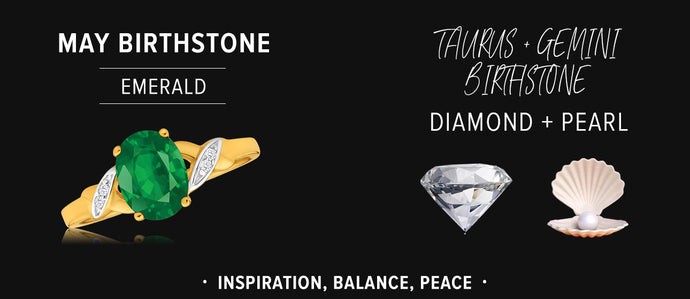May Birthstone
The May birthstone is the enchanting and almost mysterious emerald. Coming in a rich green to blue-green hue (which is said to darken over time), its colour is practically unmatched; making emeralds one of the most sought after stones in the world next to the ruby, sapphire and of course, diamonds. Arguably rarer and more valuable than diamonds, emeralds are one of the most recognisable gemstones.
As one of the oldest gemstones in the world, emeralds also have a long-winded history that goes back as far as 2 billion years. Read on to learn everything there is to know about the May birthstone from its compounds to its symbolism and even explore some exquisite emerald jewellery.
OVERVIEW OF THE MAY BIRTHSTONE:
- Meaning & physical compounds of emeralds
- The history of emeralds
- Where do emeralds come from?
- Our favourite emerald jewellery

MEANING AND PHYSICAL COMPOUNDS OF EMERALDS
The emerald is a mineral from the beryl family. It gets its vibrant colour from trace amounts of chromium and sometimes even vanadium. Natural emeralds are formed in pegmatite deposits or hydrothermal veins within metamorphic environments.
When emeralds form in a hydrothermal vein, hydrothermal fluids have been released from magma deep within the earth’s crust. These fluids contain the components within emeralds and when they begin to cool and dry up in the deposits veins, an emerald will form. In pegmatite deposits, magma is key to the formation of emeralds.
When the magma cools, elements remain in the liquid that helps form the emerald. At around 7.5-8 on the Mohs scale of hardness, an emerald is reasonably durable but not as durable as the King of the Gems, the diamond.
Throughout history, emeralds have taken on various meanings in different cultures. In ancient folklore, emeralds were thought to be a form of fortune-telling and if you placed one on your tongue you would be able to see into the future. Another belief is that emeralds could act as somewhat of a truth serum that helps to decipher whether your lover is telling the truth or not. Another belief in ancient folklore for these rich, vibrant stones is that they were good for improving your memory and overall focus.
Green by nature is one of the most calming shades on the colour wheel, hence why emeralds are attributed to the feeling of calm. Other elements that the emerald is believed to symbolise include growth, reflection, peace, balance, healing, fertility and passionate love. This precious gem is also attributed to relationships as it is believed to symbolise a steadfast bond.

THE HISTORY OF EMERALDS
The first emeralds were mined in Ancient Egypt back in 1500 BC. Cleopatra who was the Kingdom of Egypt’s last-known ruler was known for her affinity with coloured gemstones, particularly emeralds which she was particularly passionate about. She had many in her incredibly lavish jewellery collection and even presented them as gifts to foreign dignitaries when they left Egypt.
In 1817, the previously lost emerald mines that Cleopatra claimed from the Greeks was found near the Red Sea. Not surprisingly, the supply of emeralds had long been exhausted thanks to heavy mining during 3000 and 1500 BC. Also known for her vast jewellery collection which includes a large emerald necklace or emerald pendant and matching pair of emerald earrings, it’s no surprise that Elizabeth Taylor is most famous for portraying the ancient queen in the early 1960s, they’re practically twin souls after all.
The earliest appearance of emeralds in Western literature is within Aristotle's writings. The Ancient Greek Philosopher was a big fan of the stone. He believed that owning an emerald would help increase a person’s presence and speech in business, help them gain victory in trials and help settle trials. Emeralds were also a feature in Ancient Rome where they were sold in markets as it was believed that no harm came to a person or persons as long as they had their trusty emerald nearby.
Emperor Nero who was known to be somewhat short-sighted is believed to have used an emerald glass eye to watch gladiatorial contests at the coliseum. Emeralds were also held in high regard with the Incas, a group that flourished in the Andean region of South America in the early 15th century AD up until the late 1500s when they were the Spanish. The Incas are said to have owned an emerald that was bigger than an ostrich egg, which they believed to be inhabited by Esmerelda, the chief goddess of Peru.
Today, emeralds are lauded by many, including dignitaries as well as the rich and famous. Modern-day royals are especially fond of emeralds, particularly members of the British Royal Family. Princess Diana of Wales was known to be a fan of these rare beauties having owned several emerald pieces throughout her life including an elegant art-deco inspired choker necklace which she famously wore as a very-80s headband during her tour of Australia with Prince Charles.
As any queen should, Queen Elizabeth II also has her fair share of emerald jewellery in her private collection, including a pair of drop earrings, a pendant necklace and her Vladimir tiara which is one of her most recognisable crowns. Most recently, Princess Eugenie of York borrowed one of her grandmother’s emerald tiaras for her 2018 wedding.

WHERE DO EMERALDS COME FROM?
A majority of the world’s emeralds are mined from Zambia, Brazil and Colombia. Colombia is however the leading exporter of emeralds, they account for around 70-90% of the gemstones in the world’s emerald market. It is believed that the Colombians have been mining the stones for over 4000 years. During the Spanish conquest of South America, a large portion of emerald deposits was taken and therefore are only known to naturally occur in a mine in Bogota, Columbia.
The largest emerald to ever be mined is the Bahia Emerald. Weighing approximately 1,700,000 carats or 341 kilograms, the Bahia Emerald was first discovered within a mine near Bahia, Brazil in 2001. It is a rock with large emeralds embedded into it rather than being a solid gemstone, it is said to be worth $400 million.
The stone narrowly avoided being destroyed forever when it was placed in a storage facility in New Orleans, Louisiana during Hurricane Katrina-one of the United States’ most tragic natural disasters. Since mid-2008, the stone has been locked up within a secure facility in Los Angeles, California.

OUR FAVOURITE EMERALD JEWELLERY
Popular for its vibrant green colour, emerald jewellery is actually a combination of elements, including vanadium, chromium, and iron. As a result, emerald cuts can come in all shades of green, from almost blue-green to pale yellow-green. Be sure to check out our emerald rings, emerald bracelets and more! Check out some of our top May birthstone jewellery picks below!









































